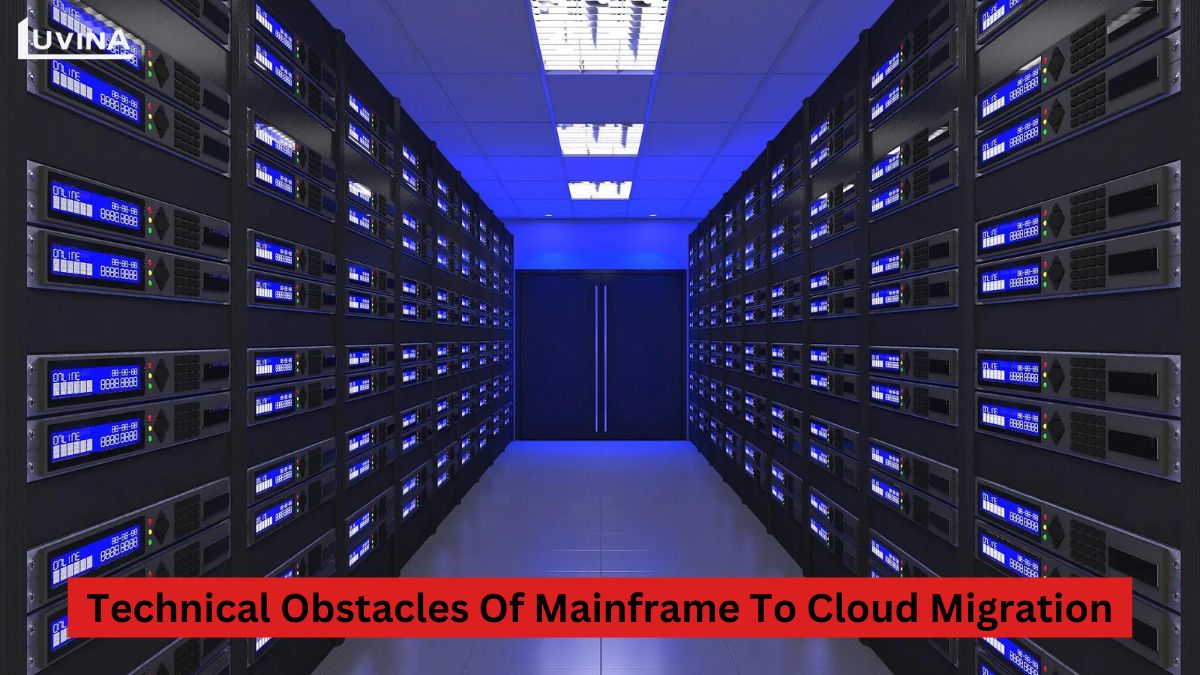Businesses frequently transition from mainframes to cloud computing in the quickly changing IT environment of today. Enterprise computing has always been built on mainframes, but switching to the cloud has major cost, flexibility, and scalability benefits.
The problems and techniques related to mainframe migration are covered in this article. It also discusses the instruments at hand to guarantee the dissemination of the transformation that has been accomplished. Kindly carry on!
Mainframe to Cloud Migration Challenges
There are several advantages to moving mainframes to the cloud, including more flexibility, cost-effectiveness, and scalability. However, this shift is challenging and has to be planned and carried out carefully.
1. Technical Challenges
The migration of complex mainframe systems to cloud environments is hindered by several technical obstacles. Adapting heavily customized systems to cloud standards can be complex due to a lack of standardized protocols. Additionally, handling and ensuring the integrity of large datasets during the migration process presents significant challenges, requiring meticulous planning and execution.

Finally, selecting appropriate technology stacks and tools from the rapidly evolving cloud landscape is crucial for a successful migration from mainframe to cloud.
2. Management Challenges
Successful mainframe to cloud migration requires meticulous planning, encompassing timelines, resource allocation, and risk mitigation. Organizations must also implement robust change management strategies to address employee resistance and ensure smooth user adoption. Moreover, acquiring new skills or hiring additional personnel may be necessary to support the complexities of the cloud environment.
3. Business Risks
Mainframe application migration to cloud is a significant financial undertaking, requiring substantial investments in infrastructure, software, and professional services. The migration process itself can be time-consuming, potentially disrupting normal business operations. Maintaining the quality of applications and data throughout the mainframe to cloud migration is critical to prevent service interruptions and ensure continued business performance.
Furthermore, safeguarding sensitive data during migration and within the cloud environment is paramount to prevent data breaches and reputational damage. Adherence to industry regulations and standards is essential to mitigate legal and financial risks.

Benefits of migrating mainframe to cloud
Migrating from mainframe to cloud can bring several benefits for businesses.
1. Simplified maintenance and risk reduction
Maintaining mainframes can be very complex, costly, and risky. Businesses must handle software updates, hardware replacements, and cybersecurity on their own. By moving to the cloud, these burdens can be taken on by cloud service providers, freeing up internal resources and reducing the risk of data loss, system errors, or security breaches.
2. Improved flexibility and scalability
This is a key benefit of migrating mainframes to the cloud. Compared to rigid mainframe systems, cloud platforms offer better flexibility and scalability. The cloud can adjust resources based on changing workloads, allowing businesses to quickly respond to market changes and use resources in the most efficient way.
3. Enhanced data management and access
Cloud environments offer secure and flexible data storage and management options. Advanced analytics tools and multiple access points allow businesses to extract greater value from their data. Additionally, the resilient cloud infrastructure ensures continuous access to important applications and data.

4. Reduced dependence on mainframe expertise
When migrating from mainframes to the cloud, cloud service providers employ expert teams to manage and maintain their infrastructure. This reduces the need for in-house mainframe experts. As the number of mainframe experts declines, moving to the cloud minimizes the risk of lacking critical expertise.
Mainframe to cloud migration strategy
By now, you probably understand why mainframe to cloud migration is essential for businesses. However, the success of this migration depends a lot on how it is carried out. Here are some important points to consider when creating a mainframe-to-cloud migration strategy, based on part of the 6R formula.
1. Rehosting
If you want to carry out mainframe migration to the cloud quickly, you need to rehost. This process involves moving applications from internal data centers to cloud servers using methods such as mainframe as a service and emulators to migrate the system to the cloud with minimal changes.
2. Rebuilding/Refactoring
Rebuilding and refactoring can take more time than rehosting, but they offer more benefits. To refactor for mainframe to cloud migration, businesses will need to rewrite parts or the entire application to ensure it works optimally in the cloud environment. Successfully refactored applications will run smoother and have fewer bugs because they are specifically designed to operate in the cloud.

3. Replacement/Retirement
This is the best mainframe migration strategy. However, completely retiring the mainframe is an important decision and needs careful consideration. To make this decision, you need to evaluate what the new system can offer, its ability to protect and transfer data, and consult with stakeholders to minimize losses.
4. Not to Migrate
Some businesses may choose not to migrate to the cloud, especially if their mainframe system is still new and meets their business needs. The benefits of maintaining an in-house mainframe include full control over the system and potential cost savings if managed well. However, these businesses still need to develop a mainframe-to-cloud migration strategy for the future and consider modernization even if they do not plan to move to the cloud immediately.
>> Read more: A Comprehensive Guide to Types of Cloud Migration
Mainframe to cloud migration tools
Mainframe to cloud migration is a complex process. Here are some popular tools used to carry out this process:
- IBM Cloud Migration Services provides a comprehensive suite of tools and services to facilitate mainframe to cloud migration. This includes IBM z/OS Connect Enterprise Edition, which enables z/OS data and applications to be exposed as RESTful APIs, IBM Cloud Transformation Advisor that helps assess and plan the migration of applications to the cloud, and IBM Application Discovery and Delivery Intelligence (ADDI), which provides insights into application dependencies and code structure.
- AWS Mainframe Migration offers various services and tools specifically designed for migrating mainframes to the cloud. For example, AWS Mainframe Modernization provides a managed runtime environment for refactoring mainframe applications. AWS Migration Hub offers centralized tracking for migration projects, and AWS Database Migration Service (DMS) helps migrate databases with minimal downtime.
- Microsoft Azure Mainframe Migration also supports mainframe cloud migration through various services and tools. It provides a centralized hub to assess and move workloads, integrates mainframe systems with modern cloud services, and supports the modernization of web applications.
- Google Cloud Mainframe Migration offers tools to support the mainframe to cloud migration. Google Cloud Migration Center helps plan and execute the migration, Google Cloud Apigee is an API management platform that connects mainframe systems with modern cloud services, and Google Cloud BigQuery assists in moving and analyzing datasets from mainframes.
Mainframe Migration Best Practices for a Successful Cloud Migration
To ensure the success of migration from mainframe to cloud, in addition to having a suitable mainframe migration strategy and using the mainframe to cloud migration tools, it is crucial to be aware of key considerations to minimize risks during the transition. Here are some best practices based on our real-world experience:
1. Understand the current system
Before developing a migration strategy, it is crucial to fully understand your current system. This involves documenting all inputs, outputs, priorities, and integrations with other systems. Understanding the current system helps identify redundant or outdated features that can be removed during migration, saving time and reducing unnecessary code. Prioritize applications logically to minimize risks and simplify the transition. Additionally, be aware of all integration points to avoid surprises and check for redundant data sources.

2. Develop a detailed migration plan
A detailed mainframe to cloud migration plan serves as a roadmap for all stakeholders. This plan should include information on performance requirements, system architecture, work plans, and responsibilities for developers and technicians. It should also cover the testing plan, training plan, and security measures. This comprehensive plan helps ensure a smooth migration and clear communication among all involved parties.
3. Ensure you have the necessary resources
Make sure that the migration team can collaborate with system architects and internal suppliers to secure all necessary resources for both testing and production environments.
4. Develop a Proof of Concept
Creating a Proof of Concept helps demonstrate the feasibility of your migration plan. This step can identify potential issues early and gain support from stakeholders. A successful proof of concept validates the migration approach and helps in addressing any flaws before full implementation.

5. Obtain buy-in from all stakeholders
It is essential to gain approval and support from all stakeholders to proceed with the mainframe to cloud migration. Highlight how the migration will save costs, improve performance, and enhance skills, while addressing any security concerns. Gaining broad support can facilitate acceptance and success on a larger scale.
Conclusion
Migrating mainframe to cloud is an excellent way for businesses to stay up-to-date with future technologies and achieve modernization. This transition can help companies save millions of dollars and gain unprecedented competitive advantages. However, it is also a complex process with challenges related to technology, management, and business operations.
Fortunately, Luvina can assist businesses with their mainframe migration to cloud. As a trusted partner in migrating legacy applications for over two decades, Luvina uses the latest tools and a team of experts with deep knowledge to make your modernization efforts faster and easier. Contact us today to learn more about how Luvina can support your mainframe to cloud migration.
Related Posts:









Read More From Us?
Sign up for our newsletter
Read More From Us?
Sign up for our newsletter